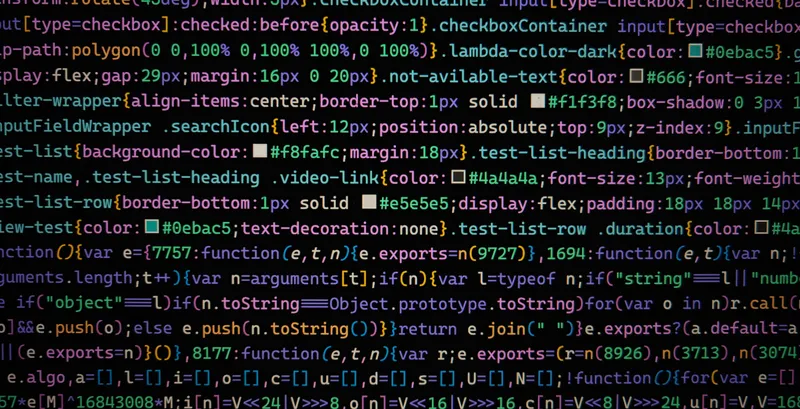
Maria Chojnowska
5 October 2023, 12 min read

What's inside
- Django
- Flask
- Pyramid
- Web2py
- TurboGears
- CubicWeb
- Bottle
- CherryPy
- Sanic
- Tornado
- Additional Considerations
- Conclusion: What Framework Will You Choose for Your Next Project?
- Comparison table
Python is a versatile, object-oriented programming language celebrated for its cross-platform compatibility and an emphasis on readable, clean source code. For a more in-depth exploration of Python's capabilities and features, you can peruse our comprehensive guide: What is Python?
The language's scope is impressively broad, encompassing everything from backend web development and API creation to data analytics, machine learning, and artificial intelligence. Python continues to command steadfast popularity among developers, in no small part due to its extensive ecosystem filled with many feature-rich libraries and high-performing frameworks.
This brings us to an intriguing question: Which of the Python frameworks are the most popular and well-received?
Join us as we delve into the specifics of 10 exceptional Python web frameworks!
Django
Django is an open source web framework, so enthusiasts and professionals at every stage of their careers use it eagerly, appreciating its features, ease of coding, and pace.
The most significant advantages of Django include an efficient ORM (object-relational mapping) system, automatic generation of the administration panel, and the web server used to check the application during the development phase.
It has been used on projects such as Instagram, Pinterest, and The Washington Times.
Essential Features
-
It provides top-notch features to assist developers with basic web development tasks - database authentication, URL routing, template engine, database schema migrations, and rational object mapping (ORM).
-
The primary databases are PostgreSQL, MySQL, SQLite, and Oracle - and Django includes them.
-
It offers built-in security features provided by cross-site scripting and clickjacking, and with its help, developers can manage sudden spikes in traffic.
-
It supports the model-view-template (MVT) structural pattern maintained by the DSF, an independent non-profit organization.
Code Sample
# mysite/urls.py
from django.urls import path
from . import views
urlpatterns = [
path('hello/', views.hello_world, name='hello_world'),
]
# mysite/views.py
from django.http import HttpResponse
def hello_world(request):
return HttpResponse("Hello, World!")
• If you want to know more about when to use Django, read our piece with examples and benefits for different industries.
Flask
Flask is a so-called microframework that doesn’t have complicated tools and libraries, a database abstraction layer, or form validation functions. The distinguishing factor is its light and modular design, which contributes to the quick and easy adaptation to various needs.
Like Django, it is mainly used in web application development, but due to its lightness and simplicity, it is applied primarily in implementing smaller projects. Flask also enables building a solid foundation for a web application.
Companies that use this framework are, among others, LinkedIn and Pinterest.
Essential Features
-
This Python web platform supports Google App Engine, built-in unit testing, and has a development server.
-
It is available under the BSD license, and its lightweight and modular design make it compatible with developers.
-
More features include being unicode based, the ability to connect any ORM, HTTP request handling, and sending RESTful requests.
Code Sample
from flask import Flask
app = Flask(__name__)
@app.route('/hello')
def hello_world():
return 'Hello, World!'
• If you're weighing the pros and cons of Flask against Django for your next project, don't miss our in-depth comparison of Django vs. Flask: Which One Should You Choose for Your Project?
Pyramid
Pyramid’s flexibility, quality, and transparency contribute to the increase in popularity among developers. Its structures are versatile. Therefore it is used for small and simple as well as large and complex projects. It allows mapping URLs and generating HTML structure.
The framework is used by technological giants such as Mozilla, Dropbox, and SurveyMonkey.
Essential Features
-
Scalability. You can use it to build microservices and full-blown web applications with many functionalities.
-
Ability to flexibly authenticate and authorize.
-
Renderers, URL generation, predicates.
Code Sample
from pyramid.response import Response
def hello_world(request):
return Response('Hello, World!')
• If you're still uncertain about which Python framework is the best fit for your upcoming project, explore our comprehensive guide: Django, Flask, or Pyramid. How to Choose the Right Python Framework for Your Project?
Web2py
It is an open-source full-stack framework for building fast, scalable, secure, and portable web applications. Web2py was developed primarily for application protection, providing validation and escape mechanisms for input data. Additionally, it enables the construction, modification, implementation, and management of network applications using web browsers.
Essential Features
-
It supports Windows, Linux, Mac, Google App Engine, and many other platforms.
-
The built-in framework supports HTTP responses, cookies, and sessions.
-
The programmer can modify the web application’s performance through web browsers or web-based IDEs.
-
It protects cross-site scripting and injection errors and helps with the MVC programming paradigm. It also provides support for internationalization.
Code Sample
# In Web2py, you define this in a controller file
def hello_world():
return "Hello, World!"
TurboGears
TurboGears allows the creation of applications that use information from databases. The framework enables developers to build extensible web applications with relatively little configuration quickly.
It contains readable templates and uses components like Genshi, Repoze, SQLAlchemy, and WebOb, which significantly improve the process of creating applications requiring connectivity with databases.
The main advantages of TurboGears are compliance with the MVC pattern, support for multiple databases, and numerous libraries.
Essential Features
-
It implements MVC style architecture and integrates large format, impressive Object Relational Mapper (ORM), and Ajax object for server and program.
-
It supports web frameworks such as Pylons.
-
It enables web developers to raise the standard of their work using JavaScript development tools.
-
Its operating system is cross-platform.
Code Sample
from tg import expose, TGController
class RootController(TGController):
@expose()
def hello(self):
return "Hello, World!"
CubicWeb
CubicWeb is a semantic web framework for efficient app development with the support of the reuse of elements (so-called cubes) while maintaining the principles of object-oriented design (OOD).
A developer can compile the cubes to construct the expected functionality.
Essential Features
-
Semantic Web Language (OWL) and Resource Definition Framework (RDF) support.
-
Facilitation of data queries with entity relationships.
-
It also supports the asset description structure.
-
It’s improved with Relational Query Language (RQL) to simplify confusion.
Code Sample
This is more pseudo-code, as CubicWeb is a bit different in structure.
from bottle import route, run
@route('/hello')
def hello():
return "Hello, World!"
Bottle
Bottle is considered a light and pleasant microframework. It allows for building low-complexity projects, and it’s used to create simple applications and prototypes.
It works with a multitude of plugins for various databases and has a built-in HTTP server. However, this is the tip of the Bottle's ability, so it's worth getting acquainted with its full potential.
Essential Features
-
It has unique routing features, templates, tools, and a basic abstraction above the WSGI standard.
-
Mapping and getting neat and dynamic URLs all work in the routing process.
-
The global search path list is used by Bottle to discover templates in the file system.
Code Sample
from bottle import route, run
@route('/hello')
def hello():
return "Hello, World!"
CherryPy
CherryPy is another object-oriented Python web microframework based on a minimalist approach. Each application built in this environment is a standalone website with its built-in, multi-threaded web server and runs on any operating system that supports Python.
CherryPy is distinguished by its built-in encoding, caching, and authentication tool. Additionally, it supports various web servers such as Apache and IIS.
Essential Features
-
Built-in functions support profiling, reporting, testing and allow using any template.
-
It has a server with a WSGI thread pool, HTTP / 1.1 compliant.
-
Powerful configuration and flexible plug.
-
Running on Python 2.7+, Python 3.1+, and Android.
-
Caching, encoding, authentication, and static content.
Code Sample
import cherrypy
class HelloWorld(object):
@cherrypy.expose
def index(self):
return "Hello, World!"
Sanic
Sanic is a simple, open-source, unopinionated web server/framework with capabilities similar to Flask. Its advantage, however, is the speed of work. It differs from other frameworks by its asynchronous action maximizes the speed of responding to HTTP requests. Sanic reads and writes cookies and supports routing schemes in the app.
Essential Features
-
Unrivaled for its speed and non-blocking capabilities.
-
It’s based on the Python 3.5+ release.
Code Sample
from sanic import Sanic
from sanic.response import text
app = Sanic()
@app.route("/hello")
async def hello(request):
return text("Hello, World!")
Tornado
Tornado is an open-source framework originally developed for FriendFeed, which Facebook acquired in 2009. It’s famous primarily for its very high efficiency.
Its structure and design enable it to handle 10,000 connections simultaneously. This amazing performance makes Tornado a great tool for building web applications to support several thousand users simultaneously.
The framework allows for the implementation of third-party authentication, authorization systems and offers the highest quality of service in real-time.
Essential Features
- It allows developers to execute third-party authentication and authorization strategies like Google, Facebook login, Yahoo BBAuth, Twitter
OAuth, etc.
-
It provides a Python-based web template language.
-
It enables applications to provide long-lived connections to its users.
-
It supports translation and localization.
Code Sample
import tornado.ioloop
import tornado.web
class MainHandler(tornado.web.RequestHandler):
def get(self):
self.write("Hello, World!")
Additional Considerations
Choosing the right Python web framework involves not just analyzing the features and licensing models but also evaluating the learning curve, community support, and performance benchmarks.
Below is a comparative analysis across these dimensions for ten popular Python web frameworks:
Learning Curve
- Django: Batteries-included and feature-rich, but can be overwhelming for newcomers.
- Flask: Ideal for beginners due to its simple and modular design.
- Web2py: Simplifies development by providing an IDE and a ticketing system, making it beginner-friendly.
- TurboGears: Steeper learning curve, as it aims to offer a full-stack framework.
- CubicWeb: Requires understanding of the 'Cube' concept, which might have a steeper learning curve.
- Bottle: Extremely simple and good for small projects, making it easy to pick up.
- CherryPy: Designed to be simple and intuitive, a good starting point for those new to web development.
- Sanic: Built for speed and designed to be simple but best suited for those with prior async programming experience.
- Tornado: Demands an understanding of asynchronous networking for best use, adding to the learning curve.
- Pyramid: Flexible but may require choices that can be difficult for beginners.
Community Support
- Django: Extensive community, tutorials, and third-party apps.
- Flask: Large and growing community with abundant resources.
- Web2py: Smaller community but generally helpful and active.
- TurboGears: Limited but dedicated community support.
- CubicWeb: Niche community, fewer resources available.
- Bottle: Small but active community, focused mainly on lightweight projects.
- CherryPy: Decent community support, though not as extensive as Django or Flask.
- Sanic: Emerging community, focus on async programming.
- Tornado: Active community especially around real-time web services.
- Pyramid: Smaller community, but often high-quality resources and support.
Performance Benchmarks
- Django: Adequate for most use-cases but generally slower due to its feature-rich nature.
- Flask: Speedy and lightweight, ideal for small to medium-sized projects.
- Web2py: Moderate performance, optimized for ease of use rather than speed.
- TurboGears: Comparable to Django in terms of speed but can be optimized.
- CubicWeb: Performance varies based on how well the 'Cubes' are optimized.
- Bottle: Extremely fast for small applications with low overhead.
- CherryPy: Offers solid performance and allows for customization for speed.
- Sanic: Designed for high-speed performance, especially with asynchronous operations.
- Tornado: Highly performant in handling long-lived network connections.
- Pyramid: Good performance, especially when optimized for specific use cases.
Conclusion: What Framework Will You Choose for Your Next Project?
Choosing the right Python web framework is a crucial decision that can significantly impact the success of your project. Whether you're looking for a comprehensive, feature-rich framework like Django, a lightweight and modular option like Flask, or something in between, Python offers diverse options tailored for varying needs and project scopes.
Django might be your best bet if you're seeking robustness and an all-inclusive environment. It's a framework of choice for large-scale projects and offers unparalleled features right out of the box. On the other hand, if you're working on a smaller, more specialized application, Flask or Pyramid could be more in line with your needs.
At Sunscrapers, we specialize in Python and Django development and have the expertise to help you make the best choice for your project. With our diverse experience across different industries and tech stacks, we're more than just a service provider; we're your trusted tech partner.
So, what framework will you choose for your next Python project? Whichever you decide, know that we're here to help you every step of the way. Contact us to find out how we can bring your project to life, offering the most effective solutions tailored to your needs.
Comparison table
| Framework | Type | License | Notable Features | Used By |
|---|---|---|---|---|
| Django | Full-Stack | BSD | ORM, admin panel, built-in security | Instagram, |
| Flask | Microframework | BSD | Lightweight, RESTful, Unicode-based | LinkedIn, |
| Pyramid | Both | BSD | Scalable, flexible authentication | Mozilla, Dropbox |
| Web2py | Full-Stack | LGPL | Supports multiple platforms, built-in HTTP responses | - |
| TurboGears | Full-Stack | MIT/LGPL/ BSD | MVC architecture, multiple DB support | - |
| CubicWeb | Full-Stack | LGPL | OWL/RDF support, RQL | - |
| Bottle | Microframework | MIT | Unique routing features | - |
| CherryPy | Microframework | BSD | Built-in encoding, caching, authentication | - |
| Sanic | Microframework | MIT | High speed, Python 3.5+ | - |
| Tornado | Both | Apache License 2.0 | Handles 10k+ connections, real-time services |


